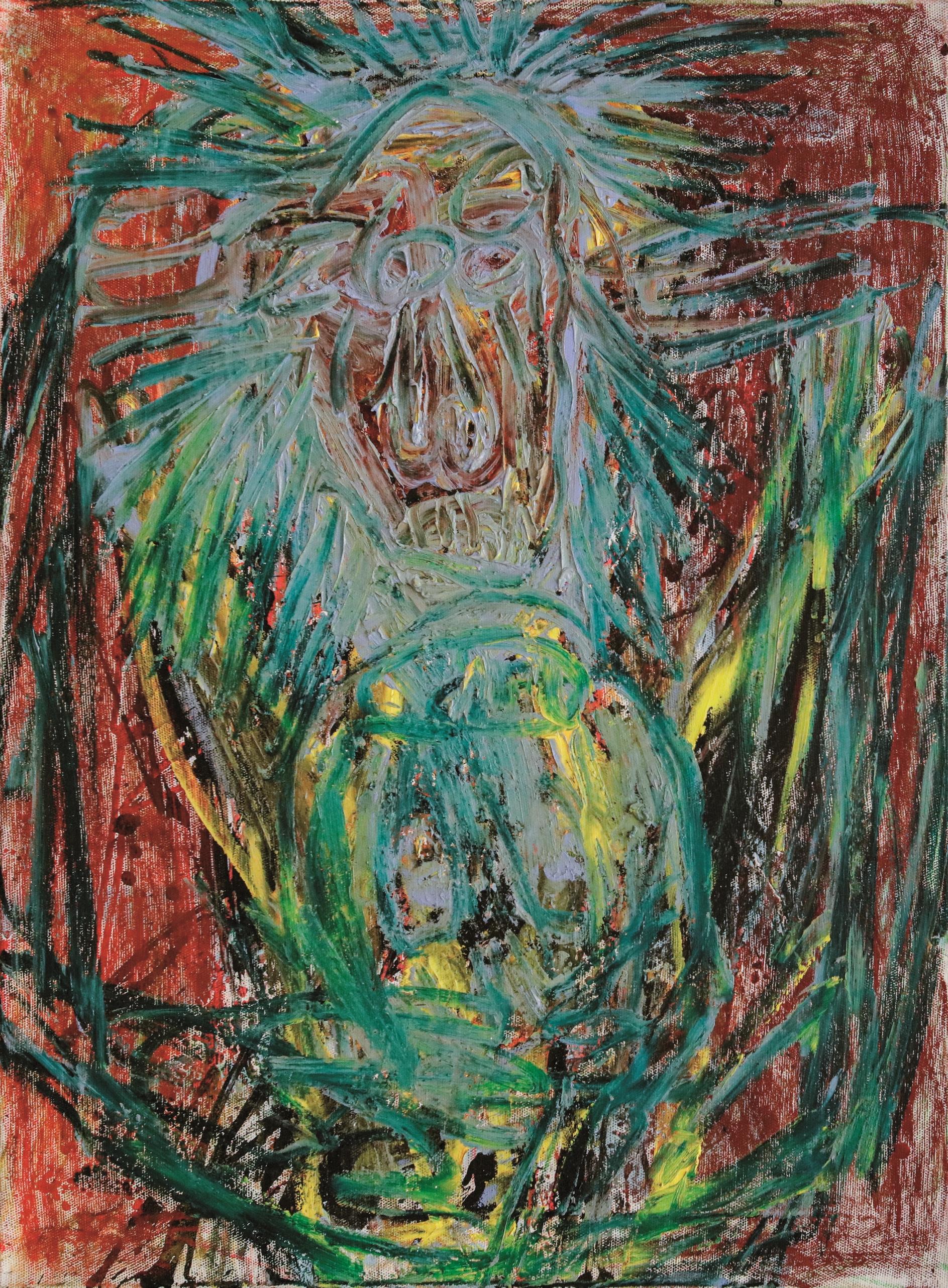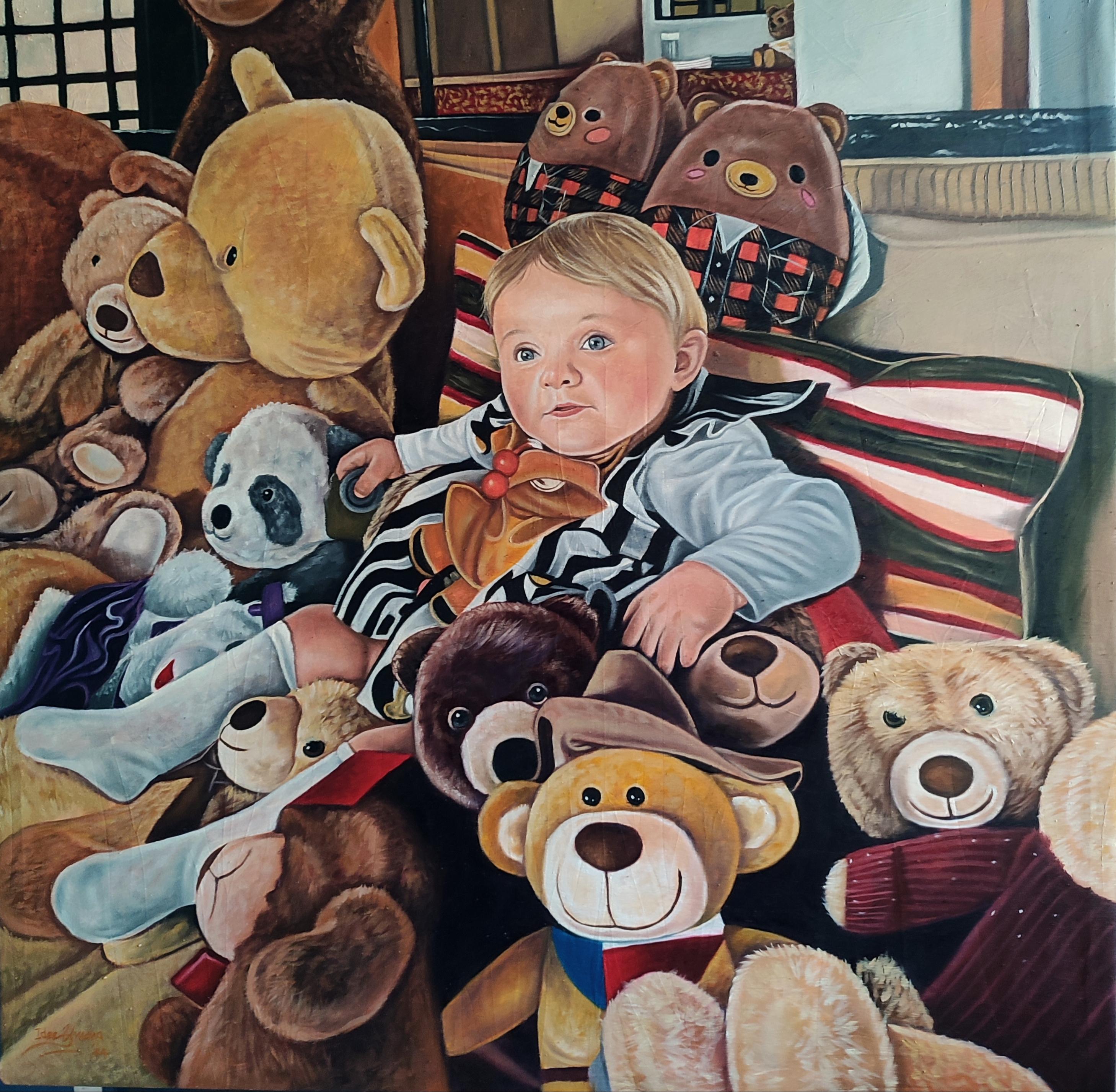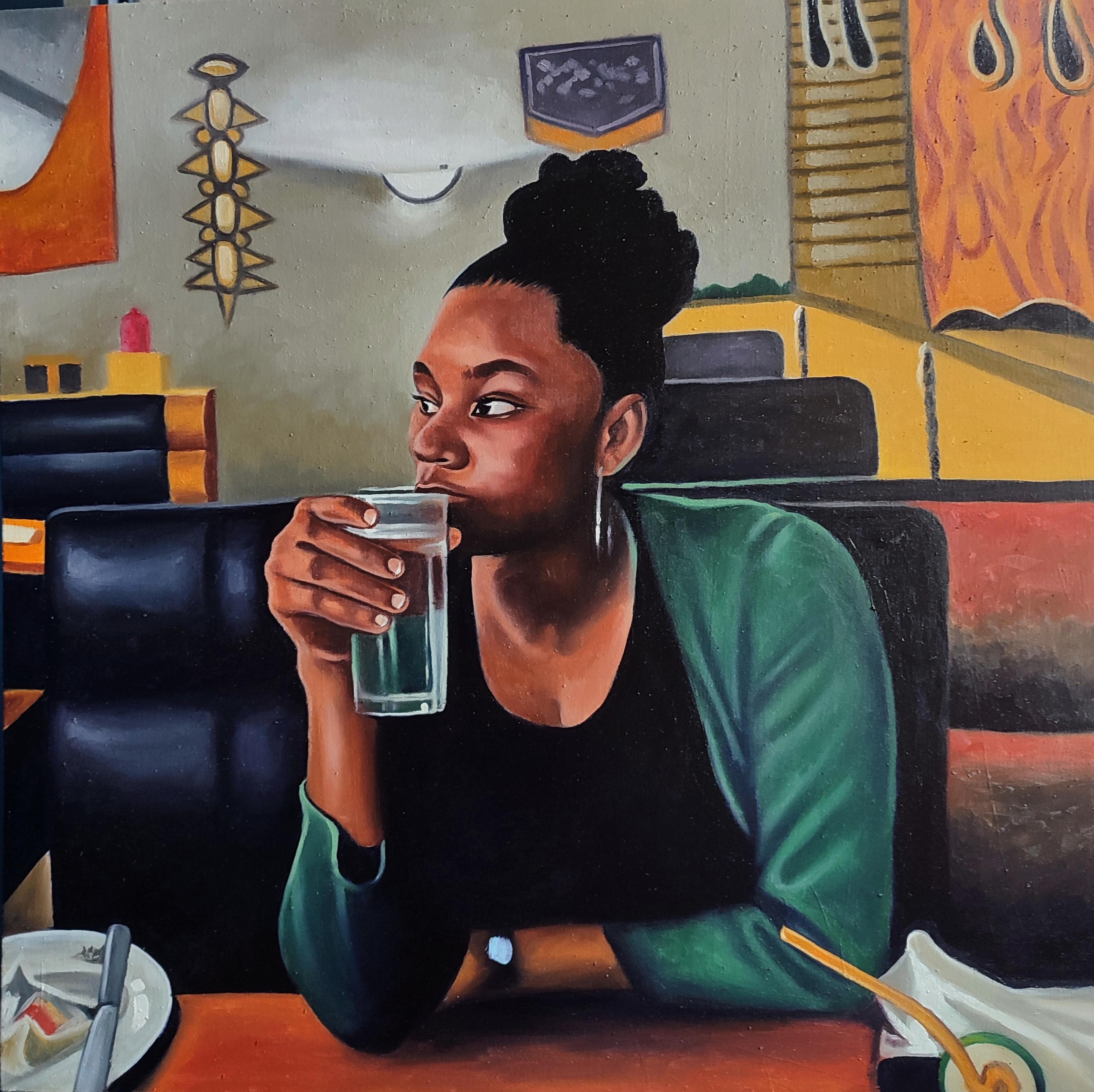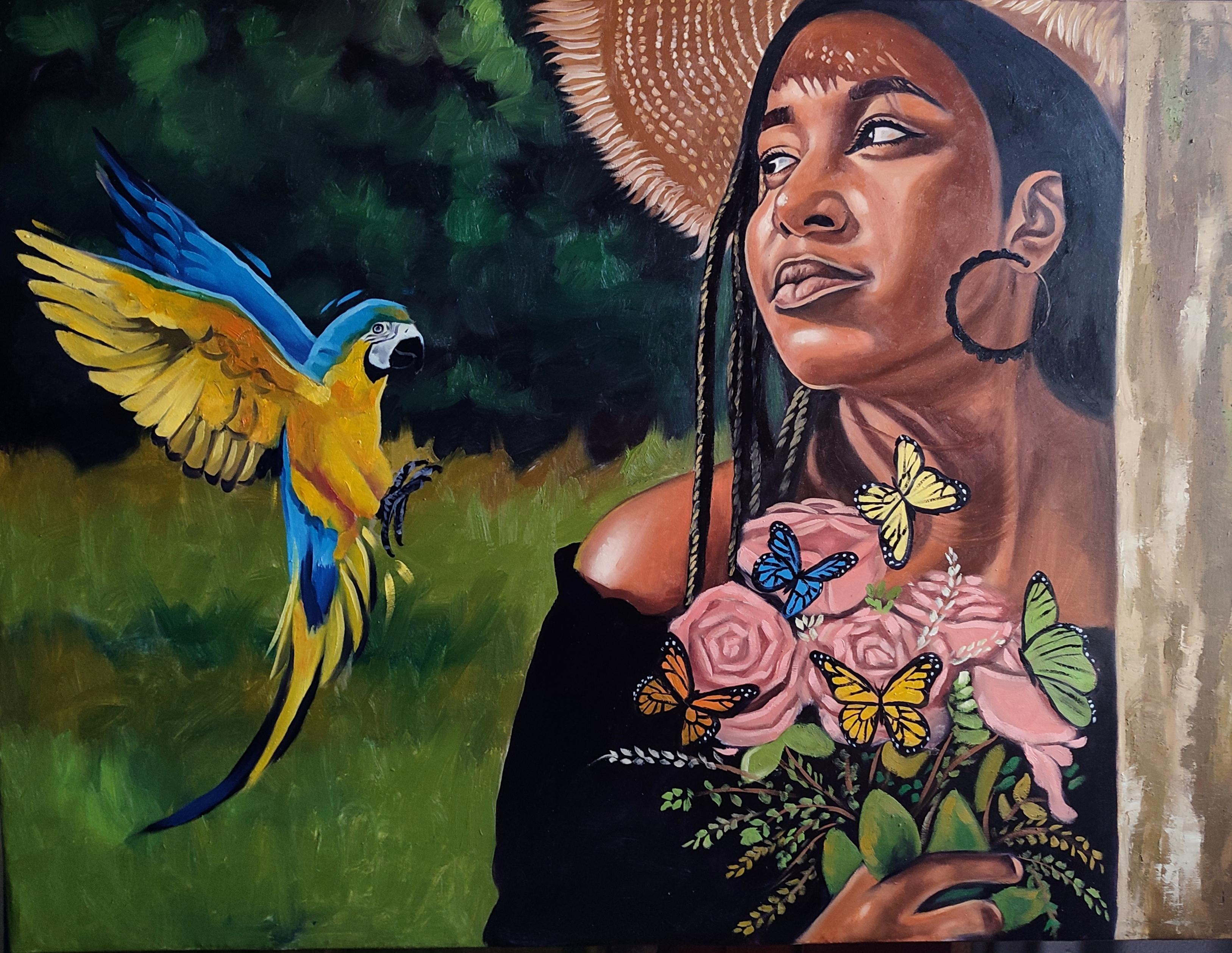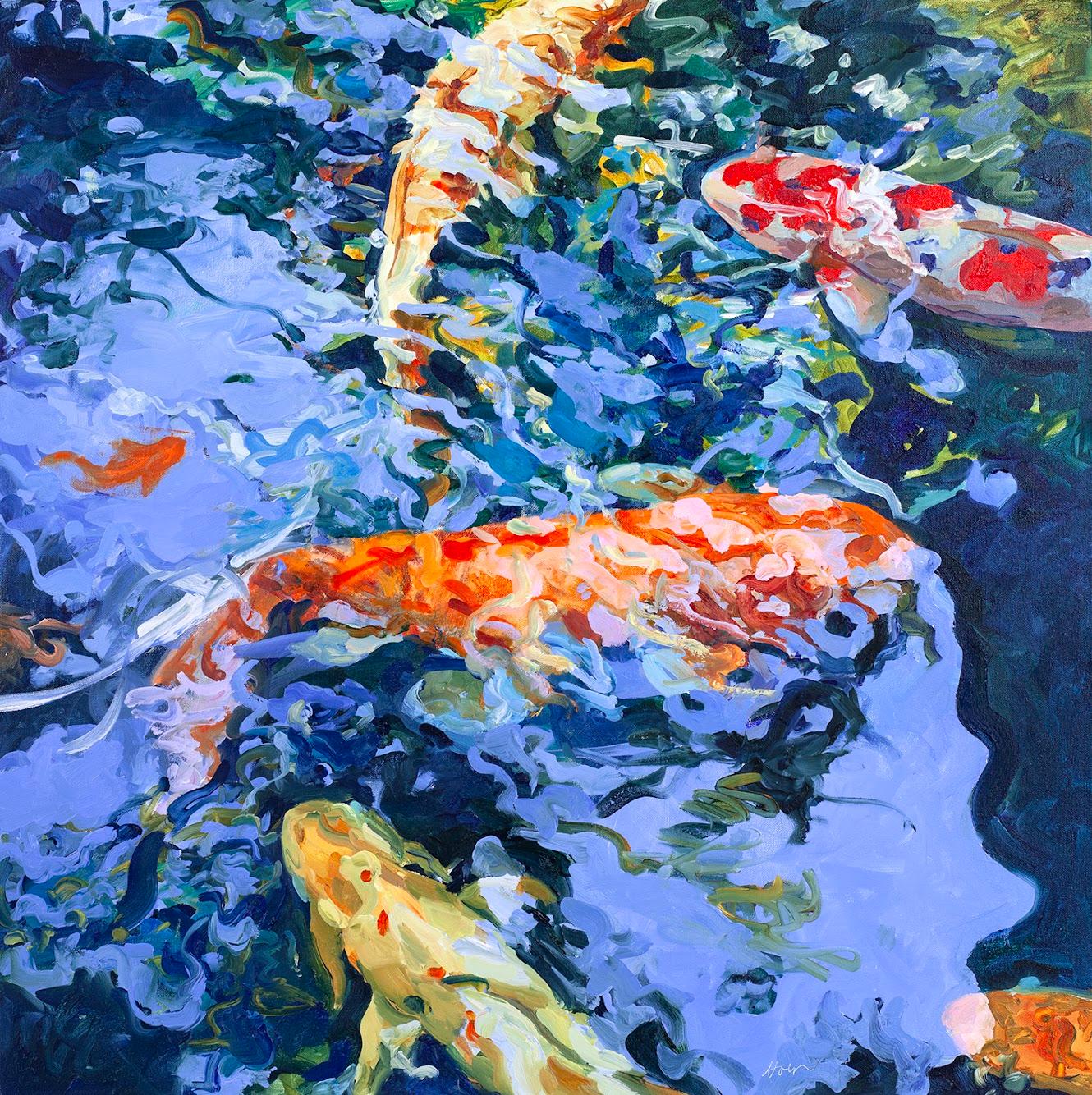Items Similar to Le Cadre Noir de Saumur - Expressionist Oil, Figures on Horse by André Brasilier
Want more images or videos?
Request additional images or videos from the seller
1 of 14
André BrasilierLe Cadre Noir de Saumur - Expressionist Oil, Figures on Horse by André Brasilierc.1965
c.1965
About the Item
Signed oil on canvas circa 1965 by French expressionist painter Andre Brasilier. The work depicts four military men in French naval uniform on black horses. A wonderful piece in the artist's distinctive style.
Signature:
Signed: Signed lower left
Dimensions:
Framed size: 28"x32"
Unframed: 20"x24"
Provenance:
Private French collection
André Brasilier was the son of the painter Jacques Brasilier. After studying in Saumur and St-Germain-en-Laye, he joined Brianchon's studio in 1949 at the École des Beaux-Arts in Paris. He was awarded the Prix Florence-Blumenthal in 1952 and the Grand Prix de Rome in 1953. He lived at the Villa de' Medicis from 1954 to 1957. He also received the Prix Charles-Morellet at the Salon de la Jeune Peinture in 1961 and the Prix de Villeneuve-sur-Lot in 1962.
Brasilier's paintings are populated by beautiful, elegant women, respectable nudes and high-class gentlemen and are set in pleasant Val-de-Loire backgrounds, resplendent with landscapes and charming towns. Revealing the distant inspiration of Gauguin and the well-assimilated influence of certain other artists, Brasilier depicts a peaceful, comfortable world, free from care, in a very simple, stylish manner, with delicate harmonies bathed in accommodating sunlight.
Brasilier took part in group exhibitions from 1956, including many in Paris: at the Salon de la Jeune Peinture; regularly at the Salon d'Automne; at the École de Paris exhibition at the Galerie Charpentier (1954-1957); at the Paris Biennale (1961 and 1963); and at the Salon Comparaisons (1961-1964). Mainly, however, he showed his work in solo exhibitions, including: at the Galerie Drouet in Paris (1959); at the Galerie Weil in Paris (1960 and 1964); at the David B. Finlay Gallery in New York (1962, 1971 and 1974); at the Atelier Mourlot in Paris (1964); at the Galerie Guiot in Paris (1967); at the Galerie de Paris (1969, 1972 and 1976); at the Yoshii Gallery in Tokyo (1969, 1974 and 1977); at the Galerie Matignon in Paris (1979); a first retrospective at the Château de Chenonceau in Paris (1980); at the Nichido Gallery in Tokyo (1983); a retrospective at the Musée Picasso in Antibes (1988); at the Galerie Hopkins-Thomas and the Galerie Étienne Sassi in Paris (1988); at the Hammer Gallery in New York (1989); André Brasilier à Bagatelle at the Hôtel de Ville in Paris (1992); at the Galerie Élysée-Matignon in Paris (1993); and at the Galerie Bac St-Germain in Paris (2002).
- Creator:André Brasilier (1929, French)
- Creation Year:c.1965
- Dimensions:Height: 28 in (71.12 cm)Width: 32 in (81.28 cm)
- Medium:
- Movement & Style:
- Period:
- Condition:Very good original condition.
- Gallery Location:Marlow, GB
- Reference Number:
About the Seller
5.0
Platinum Seller
These expertly vetted sellers are 1stDibs' most experienced sellers and are rated highest by our customers.
Established in 2001
1stDibs seller since 2016
671 sales on 1stDibs
Typical response time: 3 hours
- ShippingRetrieving quote...Ships From: Marlow, United Kingdom
- Return PolicyA return for this item may be initiated within 3 days of delivery.
More From This SellerView All
- Gardeuse de Moutons - Impressionist Figure in Landscape Oil by Julien DupreBy Julien DupréLocated in Marlow, BuckinghamshireSigned impressionist oil on canvas figure and animals in landscape by French painter Julien Dupre. The work depicts a shepherdess resting on a log as her sheep graze in the green mea...Category
1880s Impressionist Animal Paintings
MaterialsCanvas, Oil
- At the Races - Post Impressionist Horses & Figures Oil by Jacques-Emile BlancheBy Jacques Emile BlancheLocated in Marlow, BuckinghamshireSigned post impressionist horses and figures in landscape oil on canvas by French painter Jacques-Emile Blanche. The work depicts crowds of people enjoying a day at the races and watching a steeplechase horse race as the horses and their jockey's jump a fence. Signature: Signed lower right Dimensions: Framed: 28"x36" Unframed: 21"x29" Provenance: Private French collection. This work has been authenticated by Dr Jane Roberts and a certificate of authenticity will accompany the painting. Blanche received training from Gervex and Fernand Humbert. His grandfather was Émile Antoine Blanche, the psychiatrist who treated the poet Gérard de Nerval on several occasions. He was awarded a gold medal at the Exposition Universelle in Paris in 1900, and was a Commander of the Légion d'Honneur. He was well known in French and British artistic circles, and married the daughter of John Lemoine, the leader of the Diary of the Proceedings ( Journal des Débats), and author of the Life of Brummel. He exhibited his works in London and Paris. Blanche had a wide circle of acquaintances, and the list of portraits which he executed is indicative of the diversity of those who used to meet at his home: Henri Bergson; Stéphane Mallarmé; Henry Bernstein (1902); André Gide (1912); Anna de Noailles (1912); Jean Cocteau (1912); Igor Stravinsky (1915); Francis Jammes (1917); Paul Claudel (1919); Jean Giraudoux; Paul Valéry; Marcel Proust; Max Jacob (1921); Maeterlinck (1931); Debussy; Antoine Bourdelle; George Moore; André Maurois; François Mauriac; Maréchal Foch and the Princess de Broglie. He also wrote novels, which were more or less autobiographical, and essays, such as From David to Degas; Dates; From Gauguin to the Negro Review; Journals of an Artist ( De David à Degas; Dates; De Gauguin à la Revue nègre; Cahiers d'un artiste) in six volumes, and Manet. During meetings at his studio, he used to collect any snippets that would flesh out the essays he wrote, which alternated between being sharp and emotive. He gave them in series to the magazine Comoedia, under the title of Studio Talk. It was said that he aroused tremendous debate, notably with André Lhote, a painter younger than himself, who also doubled as a critic. The latter initially attempted to define the main characteristics of the art of the 'rebellious and charming Jacques Émile Blanche,' but subsequently treated him less generously, referring to a painter 'attached to the notion of 'high-and-mighty' genre painting.' He added that this sort of painting was marvellously illustrated by Manet. The quality of his flat surfaces, the precious greys and silvery light effects cause Jacques Émile Blanche to be compared more with Manet, whom he admired, than with the Impressionists, with whom he was compared in terms of his early works. Nevertheless, his outdoor backgrounds with traces of sometimes vivid colours have something in common with them. In the aftermath of World War I, he spent a long time on an enormous composition entitled Tribute to those who Died in the War. It was executed in a style which was totally different to his work as a whole. He offered this work to the church in Offranville near Dieppe. He also donated around 100 of his works to the Musée des Beaux-Arts in Rouen. He regularly exhibited in Paris, at the Salon of the Société Nationale des Beaux-Arts (also known as the Salon de Mars) from the time it was founded in 1890. At the time of the initial exhibitions held by the Société Nationale des Beaux-Arts, he rapidly gained fame by exhibiting such portraits as Paul Adam and Charles Cottet. He sometimes grouped together several members of the same family in one painting: The Painter Thaulow and His Family in 1895, The Vielé-Griffin Family, and numerous refined portraits of key figures in France and England. Apart from this Salon, for which he was one of the first driving forces and founder members, he was later to put in a great deal of effort on the occasion of the Salon des Tuileries between 1933 and 1939, even though he was by then in his seventies and already famous. He exhibited genre scenes, scenes of fashionable places - like Brighton or Dieppe - and racecourse scenes at the Salon des Tuileries in 1933. These included Family of Pedlars in London; Portrait of the Female Novelist Sylvia Thompson; Racecourses in Ireland; Arrival of the Herring in Dieppe; White Masts; Brighton; in 1934: Portrait of James Joyce; Grand National Steeplechase; Spring Races in England (sketch); Dieppe Beach; Outer Harbour of Dieppe in Autumn; in 1935: Rugby; Walter Richard Sickert; Dieppe; Tea Party at the Madeleine; in 1939: Love Thy Neighbour. Many exhibitions have been dedicated to him since his death, including one at the Musée des Beaux-Arts in Rouen in 1997, and one at the Galerie Philippe Heim in Paris in 1999. Museum and Gallery Holdings: Brussels: Portrait of the French Painter Charles Cottet Dieppe: Sleeping Child; Fish Week Dijon: General Mangin; The Sailing Ship London (Tate Collection): Francis Poictevin (1887, oil on canvas, portrait); Charles Conder (1904, oil on canvas, portrait); Ludgate Circus: Entrance to the City (November, Midday) (c. 1910, oil/panel); August Morning, Dieppe Beach (c. 1934, oil on canvas); other paintings Lyons: Portrait of Debussy Mulhouse: Begonias Paris (Louvre): The Painter Thaulow and his Family (1895) Paris (MAM): The Pink Room; The Port at Le Havre; Flowers in a Vase; Still-life; Portrait of the Artist's Mother (June 1895); Portrait of Igor Stravinsky Paris (Mus. Carnavalet): Portrait of Jean Cocteau...Category
Mid-20th Century Post-Impressionist Animal Paintings
MaterialsOil, Canvas
- Au Cirque - Post Impressionist Oil, Figures & Horse at Circus by Marcel CossonBy Jean-Louis-Marcel CossonLocated in Marlow, BuckinghamshireSigned oil on board circa 1930 by French post impressionist painter Jean-Louis-Marcel Cosson. The piece gives a behind the scenes look at a French circus. The ringmaster, dressed in ...Category
1930s Post-Impressionist Figurative Paintings
MaterialsCanvas, Oil
- L'embarquement de boeufs - Impressionist Oil, Cattle by Jean Francois RaffaelliBy Jean-Francois RaffaelliLocated in Marlow, BuckinghamshireWonderful signed oil on panel cattle and figures in landscape by French impressionist painter Jean-Francois Raffaelli. The work depicts oxen being loaded onto ships in Honfleur, France en route to England. Signature: Signed lower right Dimensions: Framed: 18"x16" Unframed: 9"x8" Provenance: Exhibition Jean Francois Raffaélli held at Galerie Simonson, 19 Rue Caumartin Paris - October 1929 (number 44) Jean-François Raffaëlli's father was a failed Italian businessman and Raffaëlli himself was, among other things, a church chorister, actor and theatre singer. He then studied under Gérôme at the École des Beaux-Arts in Paris. He travelled to Italy, Spain and Algeria and on his return to France settled in Asnières. In 1876, on a trip to Brittany, he first saw the potential of realist subject matter, if treated seriously. He became involved in meetings of artists at the Café Guerbois, where the Impressionist painters used to gather. As a result, Degas, contrary to the advice of the group, introduced Raffaëlli to the Impressionist exhibitions - according to one uncertain source as early as the very first exhibition, at the home of Nadar, and certainly to those of 1880 and 1881. In 1904, Raffaëlli founded the Society for Original Colour Engraving. He first exhibited at the Salon de Paris in 1870 and continued to exhibit there until he joined the Salon des Artistes Français in 1881, where he earned a commendation in 1885, was made Chevalier of the Légion d'Honneur in 1889 and in the same year was awarded a gold medal at the Exposition Universelle. In 1906 he was made Officier of the Légion d'Honneur. He was also a member of the Société Nationale des Beaux-Arts. In 1884, a private exhibition of his work cemented his reputation. He contributed to several newspapers such as The Black Cat (Le Chat Noir) in 1885 and The French Mail (Le Courrier Français) in 1886 and 1887. He published a collection entitled Parisian Characters, which captured his favourite themes of the street, the neighbourhood and local people going about their lives. In 1880 he participated, with Forain, on the illustration of Joris Karl Huysmans' Parisian Sketches (Croquis Parisiens). He also illustrated Huysman's Works. As well as working as an illustrator, he also made etchings and coloured dry-points. His early attempts at painting were genre scenes, but once he was settled in Asnières he started to paint picturesque views of Parisian suburbs. From 1879 onwards, his subject matter drew on the lives of local people. These popular themes, which he treated with humanity and a social conscience, brought him to the attention of the social realist writers of the time such as Émile Zola. In addition to his realist style, Raffaëlli's dark palette, which ran contrary to the Impressionist aesthethic, helped to explain the opposition of those painters to his participation in their exhibitions. More concerned with drawing than colour, he used black and white for most of his paintings. Towards the end of his life, he lightened his palette, but without adopting any other principles of the Impressionist technique. After painting several portraits, including Edmond de Goncourt and Georges Clémenceau, he returned to genre painting, particularly scenes of bourgeois life. Later in his career, he painted mainly Breton-inspired sailors and views of Venice. His views of the Paris slums and the fortifications, sites which have almost completely disappeared, went some way towards establishing a genre in themselves and perpetuated the memory of the area: The Slums, Rag-and-Bone Man, Vagabond, Sandpit, In St-Denis, Area of Fortifications. His realistic and witty portrayal of typical Parisian townscapes accounts for his enduring appeal. Born in Paris, he was of Tuscan descent through his paternal grandparents. He showed an interest in music and theatre before becoming a painter in 1870. One of his landscape paintings was accepted for exhibition at the Salon in that same year. In October 1871 he began three months of study under Jean-Léon Gérôme at the École des Beaux-Arts in Paris; he had no other formal training. Raffaëlli produced primarily costume pictures until 1876, when he began to depict the people of his time—particularly peasants, workers, and ragpickers seen in the suburbs of Paris—in a realistic style. His new work was championed by influential critics such as J.-K. Huysmans, as well as by Edgar Degas. The ragpicker became for Raffaëlli a symbol of the alienation of the individual in modern society. Art historian Barbara S. Fields has written of Raffaëlli's interest in the positivist philosophy of Hippolyte-Adolphe Taine, which led him to articulate a theory of realism that he christened caractérisme. He hoped to set himself apart from those unthinking, so-called realist artists whose art provided the viewer with only a literal depiction of nature. His careful observation of man in his milieu paralleled the anti-aesthetic, anti-romantic approach of the literary Naturalists, such as Zola and Huysmans. Degas invited Raffaëlli to participate in the Impressionist exhibitions of 1880 and 1881, an action that bitterly divided the group; not only was Raffaëlli not an Impressionist, but he threatened to dominate the 1880 exhibition with his outsized display of 37 works. Monet, resentful of Degas's insistence on expanding the Impressionist exhibitions by including several realists, chose not to exhibit, complaining, "The little chapel has become a commonplace school which opens its doors to the first dauber to come along."An example of Raffaëlli's work from this period is Les buveurs d'absinthe (1881, in the California Palace of Legion of Honor Art Museum in San Francisco). Originally titled Les déclassés, the painting was widely praised at the 1881 exhibit. After winning the Légion d'honneur in 1889, Raffaëlli shifted his attention from the suburbs of Paris to city itself, and the street scenes that resulted were well received by the public and the critics. He made a number of sculptures, but these are known today only through photographs.[2] His work was also part of the painting event in the art competition at the 1912 Summer Olympics. In the later years of his life, he concentrated on color printmaking. Raffaëlli died in Paris on February 11, 1924 Museum and Gallery Holdings: Béziers: Peasants Going to Town Bordeaux: Bohemians at a Café Boston: Notre-Dame; Return from the Market Brussels: Chevet of Notre-Dame; pastel Bucharest (Muz. National de Arta al României): Market at Antibes; Pied-à-terre Copenhagen: Fishermen on the Beach Douai: Return from the Market; Blacksmiths Liège: Absinthe Drinker...Category
1880s Impressionist Animal Paintings
MaterialsOil, Panel
- Molyvos, Ile de Lesbos - Expressionist Animal Oil Painting by André BrasilierBy André BrasilierLocated in Marlow, BuckinghamshireSigned oil on canvas animals in landscape by French expressionist painter Andre Brasilier. The piece depicts goats and birds in front of green trees with a blue sea beyond. This earl...Category
1960s Expressionist Animal Paintings
MaterialsOil, Canvas
- Horse & Rider - Expressionist Portrait Oil Painting by Gen PaulBy Gen PaulLocated in Marlow, BuckinghamshireSigned expressionist oil on board portrait circa 1950 by French painter and engraver Gen Paul. This charming work depicts a jockey wearing red jacket and breeches seated on a white horse. This work is likely a painting of the fictional character Don Quixote from the novel by Miguel De Cervantes. Paul painted this subject on numerous occasions. Signature: Signed lower right Dimensiosn: Framed: 26.5"x21.5" Unframed: 16"x11" Provenance: Private French collection of the work of Gen Paul Gen-Paul was born in the Rue Lepic, at the heart of Montmartre. His mother was an embroiderer, and his father was a café musician. Gen-Paul began painting from a young age. An apprentice interior decorative artist, he looked about him in the wealthy apartments where his work took him and observed the pieces collected by art lovers, and he learned anatomy by getting to know surgeons and going with them into operating theatres. He also attended the École des Beaux-Arts. He painted on discarded cigar boxes using coloured supplements from L'Illustration as models. This was in 1913. At the outbreak of World War I he volunteered for service and was wounded; a year later a second wound led to the amputation of his right leg. Back in Paris in 1916, he began to paint. His first oil painting, the Moulin de la Galette seen from his window, dates from 1916. His early works are not easy to identify, as he painted many views of Paris to satisfy customers who wanted a painting 'in the style of so-and-so'. In 1918 he first signed a canvas Gen-Paul. In 1920 he showed work at the Salon d'Automne, remaining faithful to this institution and to the Salon des Indépendants. His first solo show took place in the Galerie Bing in 1926. He illustrated several of Céline's books, including Journey to the End of Night, Death on Tick ( Voyage au bout de la nuit, Mort à crédit) in 1942. He also produced engravings, some of which were published as a collection entitled Views of Montmartre ( Les vues de Montmartre). When World War II ended he travelled frequently to the USA and New York. In 1952 the Galerie Drouant-David in Paris put on a retrospective dedicated to him. Gen-Paul did not exhibit much, had no dealer, and travelled frequently in France and Spain. Posthumous collective exhibitions include: Galerie Roussard...Category
1950s Expressionist Abstract Paintings
MaterialsBoard, Oil
You May Also Like
- Qilin - Timothy Archer 21st Century Painting Contemporary FigurativeBy Timothy ArcherLocated in Paris, FROil paint and pastel on canvas Signed and dated by the artistCategory
2010s Expressionist Figurative Paintings
MaterialsCanvas, Oil
- A monkey in green Julien Wolf Contemporary art painting expressionnist animalBy Julien WolfLocated in Paris, FROIl paint on canvas Hand-signed on the back by the artist “At first glance, we are invited to a colorful carnival. Everything is movement here! As if Julien Wolf had tried to captur...Category
2010s Expressionist Figurative Paintings
MaterialsCanvas, Oil
- My Happy PlaceLocated in Ibadan, OyoI believe this work of Art would remind viewers about their warm childhood, give them a rekindled desire to live, and find comfort in the people surrounding them. We all need a reason to live and to remind ourselves that it is easier to raise strong children than to repair broken men! Shipping Procedure Ships in a well-protected tube. This work is unique, not a print or other type of copy. Accompanied by a Certificate of Authenticity. About Artist IDORENYIN UMANA...Category
21st Century and Contemporary Expressionist Figurative Paintings
MaterialsOil, Canvas
- Reality Isn't What It Used To BeLocated in Ibadan, OyoShipping Procedure FREE Shipping Worldwide Ships in a well-protected tube. This work is unique, not a print or other type of copy. Accompanied by a Certificate of Authenticity. People are going through so much they are not courageous enough to speak about them because of societal prejudices. Our realities are no longer what it used to be! Often we are lost while trying to figure out ourselves and just in that moment, being lost could be a lovely place to find yourself. About Artist IDORENYIN UMANA...Category
21st Century and Contemporary Expressionist Figurative Paintings
MaterialsCanvas, Oil
- Give Me the Truth, Not RosesLocated in Ibadan, OyoIn the quest to find utopia, I realized the role of truth and honesty in society cannot be underemphasized. It takes a thousand lies to cover a truth and this could lead to damaging effects among people. A healthy relationship, family and society relies solely on the pedestal of honest and truth. I indulge my audience to not only admire the work of art but to also reflect upon this discourse. Shipping Procedure Ships in a well-protected tube. This work is unique, not a print or other type of copy. Accompanied by a Certificate of Authenticity. About Artist IDORENYIN UMANA...Category
21st Century and Contemporary Expressionist Figurative Paintings
MaterialsOil, Canvas
- "9 Koi 23" Bright Orange, Yellow, Red, White Koi Swimming in Blue/Green WaterBy Linda HoltLocated in Wellesley, MA"9 Koi 23" is a complex work of koi fish swimming underwater filled with light and brilliant color painted in a lush and fluid style bordering on abstraction. Fish are in shades o...Category
2010s Expressionist Animal Paintings
MaterialsCanvas, Oil

